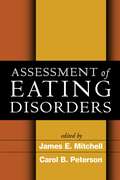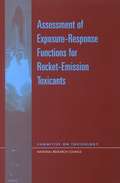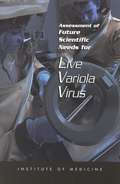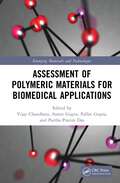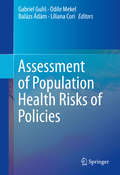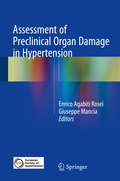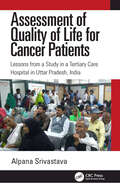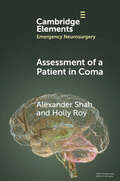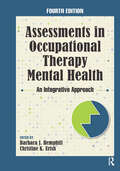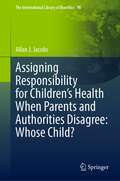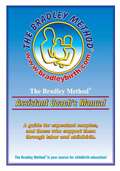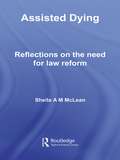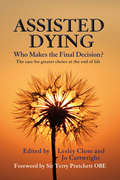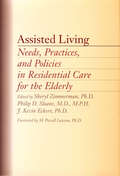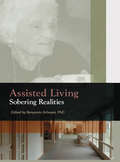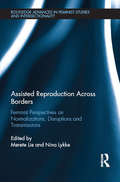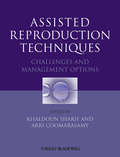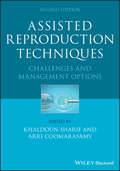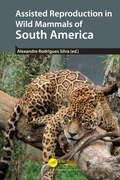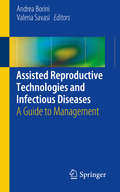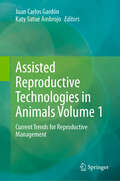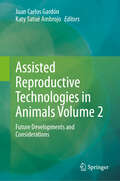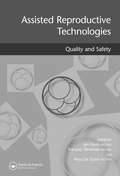- Table View
- List View
Assessment of Eating Disorders
by James Mitchell Carol B. PetersonConcise and practical yet comprehensive, this unique book provides a clear framework and a range of up-to-date tools for assessing patients with eating disorders. Leading clinicians and researchers describe the nuts and bolts of using diagnostic interviews, standardized databases, structured instruments, self-report and family-based measures, medical and nutritional assessment, ecological momentary assessment, and strategies for evaluating body image disturbance. Concrete examples and sample forms are included throughout, and the concluding chapter discusses how to use assessment data in individualized treatment planning.
Assessment of Exposure-Response Functions for Rocket-Emission Toxicants
by Subcommittee on Rocket-Emission ToxicantsThe U.S. Air Force is developing a model to assist commanders in determining when it is safe to launch rocket vehicles. The model estimates the possible number and types of adverse health effects for people who might be exposed to the ground cloud created by rocket exhaust during a normal launch or during an aborted launch that results in a rocket being destroyed near the ground.Assessment of Exposure-Response Functions for Rocket-Emmission Toxicants evaluates the model and the data used for three rocket emission toxicants: hydrogen chloride, nitrogen dioxide, and nitric acid.
Assessment of Future Scientific Needs for Live Variola Virus
by Institute of MedicineIn 1980, the World Health Organization (WHO) officially declared that smallpox had been eradicated. In 1986, WHO's international Ad Hoc Committee on Orthopox Virus Infections unanimously recommended destruction of the two remaining official stocks of variola virus, one at the Centers for Disease Control and Prevention and the other at the VECTOR laboratory in Siberia. In June 1999, WHO decided to delay the destruction of these stocks. Informing that decision was Assessment of Future Scientific Needs for Variola Virus, which examines:-- Whether the sequenced variola genome, vaccinia, and monkey pox virus are adequate for future research or whether the live variola virus itself is needed to assist in the development of antiviral therapies.-- What further benefits, if any, would likely be gained through the use of variola in research and development efforts related to agent detection, diagnosis, prevention, and treatment.-- What unique potential benefits, if any, the study of variola would have in increasing our fundamental understanding of the biology, host-agent interactions, pathogenesis, and immune mechanisms of viral diseases.
Assessment of Polymeric Materials for Biomedical Applications (Emerging Materials and Technologies)
by Sumit Gupta Pallav Gupta Partha Pratim Das Vijay ChaudharyThis book initiates with an introduction to polymeric materials, followed by various classifications and properties of polymeric implant material including various development methods of polymeric materials and their characterization techniques. An overview of various toxicology assessments of polymeric materials and polymeric materials for drug delivery system is also included. Design and analysis of polymeric materials-based components using Ansys software along with polymeric materials for additively manufactured artificial organs are also discussed. Features: Addresses assessment of polymeric materials in biomedical sciences, including classification, properties, and development of polymeric implants. Covers various topics in the field of tissue regeneration. Discusses biocompatibility, toxicity, and biodegradation of polymeric materials. Explores wide-scale characterization to study the effect of inclusion size on the mechanical properties of polymeric materials. Reviews limitations and future directions on polymeric material with emphasis on biocompatibility. This book is aimed at graduate students and researchers in biomaterials, biomedical engineering, composites, and polymers.
Assessment of Population Health Risks of Policies
by Gabriel Guliš Odile Mekel Balázs Ádám Liliana CoriAssessment of Population Health Risks of Policies Gabriel Gulis, Odile Mekel, Balázs Ádám, and Liliana Cori, editors Public health continues to evolve as professionals work not only to prevent disease and promote well-being but also to reduce health disparities and protect the environment. To a greater extent, policy is intimately linked to this process, a reality that is gaining traction in the public health sector. With this understanding in mind, Assessment of Population Health Risks of Policies introduces an international set of guidelines, Risk Assessment from Policies to Impact Dimension (RAPID). In keeping with widely recognized models of public health operations, this innovative methodology factors in social, environmental, and economic health determinants to predict adverse outcomes to populations arising from large-scale policy decisions. Case studies from across the European Union illustrate both the intricacies of risk quantification and other components of assessment and possible relationships between policy and health outcomes. And contributors suggest how international health standards may be implemented despite significant cultural and political differences among nations. Included in the coverage: Public health, policy analysis, risk assessment and impact assessment Risk assessment, impact assessment and evaluation Top-down versus bottom-up policy risk assessment Quantification of health risks Application of RAPID guidance on an international policy Use of policy risk assessment results in political decision making Assessment of Population Health Risks of Policies is an essential and proactive read for researchers and practitioners in impact assessment, public policy, public health, and epidemiology.
Assessment of Preclinical Organ Damage in Hypertension
by Giuseppe Mancia Enrico Agabiti RoseiThis book presents up-to-date information on how to assess early preclinical alterations in the heart, the small and large arteries and the kidney using the most sensitive, specific and cost-effective techniques. A wide variety of techniques are discussed, with careful attention to the latest developments. For each organ, evidence is documented regarding the prevalence of organ damage in the general and the hypertensive population. Information is provided on the potential induction of regression of organ damage by treatment, the criteria for establishing significant changes and the clinical prognostic significance of regression. The manual will be invaluable for all practitioners responsible for the clinical management of hypertensive patients, given that the assessment of early preclinical cardiovascular and renal damage permits more accurate risk stratification at baseline and facilitates evaluation of cardiovascular protection when regression of structural changes is achieved during treatment.
Assessment of Quality of Life for Cancer Patients: Lessons from a Study in a Tertiary Care Hospital in Uttar Pradesh, India
by Alpana SrivastavaCancer is a deadly disease that puts not only physical and financial pressure on the patient but also even more psychological pressure. Physical deterioration in health and financial losses are easy to see but the psychological effects are not as visible; however, the psychological aspects are an important component in measuring any patient’s Quality of Life (QoL, or balance between physical, psychological, social, and spiritual components).The present study is a small step in the direction of measuring QoL of cancer patients and the potential positive impact of changes in counselling. The association between QoL and other parameters, especially fear, leads to the recommendation to set up counselling centres at each hospital in its oncology department.
Assessment of a Patient in Coma (Elements in Emergency Neurosurgery)
by Alexander Shah Holly RoyThe authors start with definitions and classification of a depressed conscious state and proceed to detail practical tips in the initial assessment of patients with coma, focussing on the history and examination. They impress the number of non-neurological causes of coma, which may need to be considered. The assessment of pupillary responses, eye movement abnormalities and abnormal breathing patterns are described. They also explore the utility of basic initial investigations, including blood gases and briefly discuss specialist neuro-imaging and electroencephalography.
Assessment of the AHRQ Patient Safety Initiative
by Michael D. Greenberg Cheryl L. Damberg Donna O. Farley Melony E. Sorbero M. Susan RidgelyUpdates the policy context of the Agency for Healthcare Research and Quality (AHRQ) patient safety initiative; documents the current priorities and activities undertaken; and assesses contributions of health information technology projects and dissemination actions to support adoption of evidence-based safe practices. Discusses implications for future AHRQ policy, programming, and research; suggests ways to strengthen AHRQ activities.
Assessments in Occupational Therapy Mental Health: An Integrative Approach
by Barbara J. Hemphill Christine K. UrishAssessments in Occupational Therapy Mental Health: An Integrative Approach, Fourth Edition is a unique compilation of mental health assessments that are taught in occupational therapy academic programs and used in clinical practice. This highly anticipated Fourth Edition provides the occupational therapy student and educator with knowledge about the evaluation process, assessments that are current and accurate, and how to generate research for developing assessment tools. Assessments in Occupational Therapy Mental Health, Fourth Edition by Drs. Barbara J. Hemphill and Christine K. Urish, along with more than 30 world-renowned contributors, includes 15 new assessments, along with updates to 9 assessments from the previous editions. Also incorporated throughout the text is the AOTA’s Occupational Therapy Practice Framework, Third Edition. Each chapter includes: A theoretical base on the assessment including historical development, rationale for development, behaviors assessed, appropriate patient use, review of literature, and assessment administration How the instrument is administered, which includes the procedure, problems with administering, and materials needed The presentation of a case study and interpretation of results Statistical analysis and recent studies Suggestions for further research to continue the development and refinement of assessments in occupational therapy mental health New to the Fourth Edition: Kawa Model Assessment Spirituality Model of Human Occupation Assessments Assessments Measuring Activities of Daily Living Some of the topics included in the Fourth Edition: Evidence-based practice The interviewing process Psychological assessments Cognitive assessments / learning assessments Behavioral assessments Biological and spiritual assessments While introducing new assessments and updated information, Assessments in Occupational Therapy Mental Health: An Integrative Approach, Fourth Edition is ideal for occupational therapy faculty, students, practitioners, as well as nurses, psychologists, and social workers.
Assigning Responsibility for Children’s Health When Parents and Authorities Disagree: Whose Child? (The International Library of Bioethics #90)
by Allan J. JacobsThis book provides a multidisciplinary analysis of the potential conflict between a government’s duty to protect children and a parent(s)’ right to raise children in a manner they see fit. Using philosophical, bioethical, and legal analysis, the author engages with key scholars in pediatric decision-making and individual and religious rights theory. Going beyond the parent-child dyad, the author is deeply concerned both with the inteests of the broader society and with the appropriate limits of government interference in the private sphere. The text offers a balance of individual and population interests, maximizing liberty but safeguarding against harm. Bioethics and law professors will therefore be able to use this text for both a foundational overview as well as specific, subject-level analysis. Clinicians such as pediatricians and gynecologists, as well as policy-makers can use this text to achieve balance between these often competing claims. The book is written by a physician with practical and theoretical knowledge of the subject, and deep sympathy for the parental and family perspectives. As such, the book proposes a new way of evaluating parental and state interventions in children's’ healthcare: a refreshing approach and a useful addition to the literature.
Assignment: Baby
by Lynne MarshallDr. Hunter Phillips has to look after his little baby niece for a month. He's completely besotted and totally out of his depth! As if that weren't enough, he also finds himself working with his ex-wife, Amanda--the woman who left him when he told her he didn't want children. Hunter is still fiercely attracted to Amanda, and she's amazing with baby Sophie. As they pretend to play at happy family, Hunter begins to realize that winning Amanda back and having a family for real might be what he really wants after all....
Assistant Coach's Manual
by Marjie Hathaway Susan Bek Coni ShermanThis is the Bradley Method(r) manual for Assistant Coach's at natural childbirth. Assistant coach's, sometimes called doulas are helpers at birth. This manual will help family members, and others, to be effective in supporting mothers and fathers as they do what well may be the most important work of their lives.
Assisted Dying: Reflections on the Need for Law Reform (Biomedical Law and Ethics Library)
by Sheila McLeanAssisted Dying explores the law relating to euthanasia and assisted suicide, tracing its development from prohibition through to the laissez faire attitude adopted in a number of countries in the 21st Century. This book provides an in-depth critique of the arguments surrounding legislative control of such practices and particularly looks into the regulatory role of the state. In the classical tradition of libertarianism, the state is generally presumed to have a remit to intervene where an individual’s actions threaten another, rather than harm the individuals themselves. This arguably leaves a question mark over the state’s determined intervention, in the UK and elsewhere, into the private and highly personal choices of individuals to die rather than live. The perceived role of the state in safeguarding the moral values of the community and the need for third party involvement in assisted suicide and euthanasia could be thought to raise these practices to a different level. These considerations may be in direct conflict with the so called right to die espoused by some individuals and groups within the community. However this book will argue that the state’s interests are and should be second to the interests that the people themselves have in choosing their own death. Assisted Dying is winner of the The Minty Prize of the Society of Authors, and winner of the Royal Society of Medicine Book Awards, 2008
Assisted Dying: Who Makes the Final Decision
by Terry Pratchett Jo Cartwright Lesley CloseThe latest developments in the arguments for and against assisted dying, with a foreword by Terry PratchettAssisted dying is perhaps one of the most divisive issues of the modern age, generating endless headlines and moral debates. Published in conjunction with the organization Dignity in Dying, this important book provides a forum for expert commentators in a variety of fields, including religion and medicine, to explore whether the most humane response to the torment and helplessness of certain severely incapacitated individuals is to assist them in their wish to die. This collection is edited by two proponents of greater choice at the end of life, and all the contributors support the need to change the law. Starting from a position that the current legal situation is untenable, detailed case studies shed light on the negative consequences of the current state of the law which forbids assisted dying, and the lack of choices offered to dying people who are suffering intolerably at the moment. The book's case studies punctuate chapters, written by a variety of authors, about different aspects of the subject: these chapters attempt to address the concerns raised by the case studies.
Assisted Living: Needs, Practices, and Policies in Residential Care for the Elderly
by Sheryl ZimmermanWith the number of elderly persons needing long-term care expected to double to 14 million over the next two decades, assisted living has become the popular choice for housing or care. Assisted living represents a promising model of long-term care that blurs the sharp distinction between nursing homes and community-based care and reduces the gap between receiving long-term care in one's own home and in an "institution." Assisted Living: Needs, Practices, and Policies in Residential Care for the Elderly examines the evolving field of residential care and focuses on national issues of regulation, reimbursement, and staffing. The book is based on a four-state study of assisted living facilities and describes the facilities, the persons residing in them and their needs, and how the services vary by facility. Because one-third to two-thirds of residents in assisted living facilities have cognitive impairment, special attention is devoted to dementia care. The book also focuses on how today's long-term health care environment evolved, and it examines the future direction and implications of assisted living.Assisted Living: Needs, Practices, and Policies in Residential Care for the Elderly brings together a group of nationally recognized experts to help define the types of residential care that should be encouraged and sets guidelines for selecting an appropriate type of facility.
Assisted Living: Sobering Realities
by Benyamin SchwarzLearn how to make elder housing more homelike!Taking an incisive look at assisted living for the elderly, Assisted Living: Sobering Realities is an important book for the professionals who work with aging Americans and their families. This vital book provides a multidisciplinary overview of the world of assisted living for older Americans. With unique insight and a keen clinical perspective, Assisted Living examines a variety of topics: the dilemma of aging in place, the realities of end-of-life care, and the ins and outs of residential care supply. Easy-to-read graphs and charts make the data user-friendly.This book delivers current information on: the housing needs of elderly renters, with case studies of 109 residents in two facilities the need for improved housing and services for low-income elderly, providing an overview of how successful facilities take a comprehensive approach in linking low-income elders with community-based services the advantages and disadvantages of residential care facilities research about aging in place from providers and residents&’ perspectives the unmet needs of the elderly who qualify for housing assistance how visitation patterns affect the overall satisfaction and quality of life of assisted living residents
Assisted Reproduction Across Borders: Feminist Perspectives on Normalizations, Disruptions and Transmissions (Routledge Advances in Feminist Studies and Intersectionality)
by Merete Lie Nina LykkeToday, it often seems as though Assisted Reproductive Technologies (ARTs) have reached a stage of normalization, at least in some countries and among certain social groups. Apparently some practices – for example in vitro fertilization (IVF) – have become standard worldwide. The contributors to Assisted Reproduction Across Borders argue against normalization as an uncontested overall trend. This volume reflects on the state of the art of ARTs. From feminist perspectives, the contributors focus on contemporary political debates triggered by ARTs. They examine the varying ways in which ARTs are interpreted and practised in different contexts, depending on religious, moral and political approaches. Assisted Reproduction Across Borders embeds feminist analysis of ARTs across a wide variety of countries and cultural contexts, discussing controversial practices such as surrogacy from the perspective of the global South as well as the global North as well as inequalities in terms of access to IVF. This volume will appeal to scholars and students of anthropology, ethnography, philosophy, political science, history, sociology, film studies, media studies, literature, art history, area studies, and interdisciplinary areas such as gender studies, cultural studies, and postcolonial studies.
Assisted Reproduction Techniques: Challenges and Management Options
by Khaldoun Sharif Arri CoomarasamyAssisted reproduction techniques have led to the birth of 4 million babies worldwide Assisted reproduction techniques (ART), in particular in-vitro fertilization and intra-cytoplasmic sperm injection, are the most advanced forms of infertility treatment. They involve numerous counseling, medical, surgical and laboratory-based steps. At each step various problems and complications could be encountered that challenge even the most experienced ART practitioners. Moreover, patients with complex medical disorders may require ART, presenting further challenges. Assisted Reproduction Techniques will stimulate resourceful thinking in the ART practitioner when faced with these challenges. It outlines various management options, the reasoning behind them, and the evidence on which they are based to enable the practitioner to choose the most suitable solution for the needs of each patient. Written by 122 internationally renowned experts, Assisted Reproduction Techniques follows the patient's journey throughout the whole ART process, with chapters on: Counseling and preparation Ovarian stimulation Oocyte retrieval Embryo transfer The luteal phase The ART laboratory The male patient The ART pregnancy Each of the 100 concise chapters includes clinical cases, background, evidence-based practical management options, preventive measures and key-point summaries of the important details. Assisted Reproduction Techniques gives a wide-ranging practical guide to all those wishing to support couples who cannot conceive naturally.
Assisted Reproduction Techniques: Challenges and Management Options
by Khaldoun Sharif Arri CoomarasamyAssisted reproduction techniques have led to the birth of 8 million babies worldwide Assisted reproduction techniques (ART), in particular in-vitro fertilization and intra-cytoplasmic sperm injection, are the most advanced forms of infertility treatment. They involve numerous counseling, medical, surgical and laboratory-based steps. At each step various problems and complications could be encountered that challenge even the most experienced ART practitioners. Moreover, patients with complex medical disorders may require ART, presenting further challenges. Assisted Reproduction Techniques will stimulate resourceful thinking in the ART practitioner when faced with these challenges. It outlines various management options, the reasoning behind them, and the evidence on which they are based to enable the practitioner to choose the most suitable solution for the needs of each patient. Written by 171 internationally renowned experts, Assisted Reproduction Techniques follows the patient's journey throughout the whole ART process, with chapters on: Counseling and preparation Pituitary suppression and ovarian stimulation Oocyte retrieval Embryo transfer The luteal phase The ART laboratory The male patient The ART pregnancy <li style="margin: 0in 0in 0in 0.75in; font-size: 11pt; font-family: Calibri, sans-serif; text-align: justify; vertical-align: baseline; user-select: text; -webkit-user-drag: none; -webkit-tap-highlight-color: transparent; cur
Assisted Reproduction in Wild Mammals of South America
by Alexandre Rodrigues SilvaSouth America has one of the greatest riches in the world in terms of biodiversity. Despite all this richness, recent reports warn of different threats to this biodiversity. As a strategy to reduce the rate of loss of animal species, the development and application of assisted reproduction techniques (ARTs) for their conservation currently stands out. Thus, this book compiles information on recent scientific studies regarding the development of ARTs for the conservation of wild mammalian species in South America, thus serving as an important source of reference for professionals and students interested in wildlife conservation.
Assisted Reproductive Technologies and Infectious Diseases: A Guide to Management
by Andrea Borini Maria Valeria SavasiThis concise and practical book is the first of its kind to examine the use of assisted reproductive technologies (ART) in relation to blood-borne infectious diseases: human immunodeficiency virus (HIV), hepatitis B (HBV) and hepatitis C (HCV). The book opens with a discussion of the impact of these viruses on male and female fertility, followed by specific chapters of each of them, including ART with HIV and HCV serodiscordant couples (where either the male or female is positive) and the detection and impact of HBV and HCV in human gametes and embryos. An important character on laboratory safety when performing ART with blood-borne viruses follows, and the book concludes with a discussion of ART in austere and resource-poor settings, where these infections are often dominant due to lack of treatment and access to vaccines. Written and edited by an international array of experts in reproductive medicine, Assisted Reproductive Technologies and Infectious Diseases explores questions, techniques, and related issues with the aim of effectively helping clinicians working with serodiscordant couples wishing to have children.
Assisted Reproductive Technologies in Animals Volume 1: Current Trends for Reproductive Management
by Juan Carlos Gardón Katy Satué AmbrojoThis Volume 1 of a two-volume topical collection highlights reproductive biotechnologies applied to males and females of different animal species. Organized in five parts, you will find a detailed review of the most relevant topics for reproduction management in equines, cattle, swine, and small ruminants. The authors discuss genomic selection, the use of ultrasound, sperm evaluation and conservation, oocyte retrieval, embryonic development, and significant clinical aspects such as stress and physiological impacts, including thermal conditions. Each contributor brings an own perspective, knowledge, and writing style, resulting in the latest research results, advances, and current trends in assisted reproductive technologies. The volume also includes case studies and hands-on examples to provide readers with real-life applications. The practical approach will enhance the learning experience and differentiates this work from mainly theoretical literature. Specifically tailored to the professional audience within the field of assisted animal reproduction, this book will update veterinarians, researchers, animal breeders, and advanced students. By presenting innovative techniques and approaches not widely covered in other works, this volume offers new perspectives and ideas for reproductive management.
Assisted Reproductive Technologies in Animals Volume 2: Future Developments and Considerations
by Juan Carlos Gardón Katy Satué AmbrojoThis Volume 2 of a two-volume topical collection highlights reproductive biotechnologies applied to males and females of different animal species. Organized in two parts, you will find a detailed review of the latest developments in reproduction management for equines, cattle, swine, and birds. The authors discuss the application of ultrasonography, equine cloning, animal germplasm banks, the captive breeding of threatened wild birds, as well as nanotechnologies and artificial intelligence. Vivid illustrations complement the rich information. Each contributor brings an own perspective, knowledge, and writing style, resulting in the latest research results, advances, and current trends in assisted reproductive technologies. The work also includes case studies and hands-on examples to provide readers with real-life applications. The practical approach will enhance the learning experience and differentiates this volume from mainly theoretical literature. Specifically tailored to the professional audience within the field of assisted animal reproduction, this book will update veterinarians, researchers, animal breeders, and advanced students. By presenting innovative techniques and approaches not widely covered in other works, this volume offers new perspectives and ideas for reproductive management.
Assisted Reproductive Technologies: Quality and Safety
by Petra De SutterWorldwide, approximately 500,000 in vitro fertilization cycles are performed every year. Although the best possible result is a healthy child, the technology carries a number of varying risks and complications leading to a trade-off between the efficacy of these treatments and their quality and safety. Drawing on contributions from international ex
